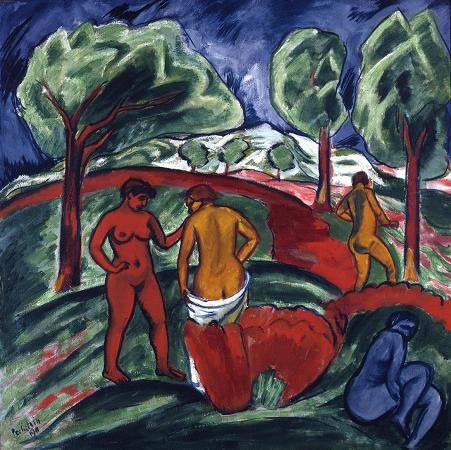Max Pechstein (1881 - 1955). Hermann Max Pechstein was a German expressionist painter and printmaker, and a member of the Die Brücke group. Pechstein was born in Zwickau, the son of a craftsman who worked in a textile mill. Early contact with the art of Vincent van Gogh stimulated Pechstein's development toward expressionism. He first worked as a decorator in his hometown before enrolling at the School of Applied Arts and then at the Royal Art Academy in Dresden, where he met the painter Otto Gussman and the architect Wilhelm Kreis. It was here starting in 1902 he became a pupil of Gussmann; a relationship that would last until 1906 when Pechstein met Erich Heckel and was invited to join the art group Die Brücke. He was the only member to have received formal art training and was an active member until 1910 where he often worked alongside Br ü cke painters creating a similar, homogenous style of this period. During this time in 1907, Pechstein traveled to Italy to receive an award and upon his return in 1908 spent time in Paris where he met Fauvist painter Kees van Dongen who he convinced to join Die Br ü cke. Later that year Pechstein moved to Berlin. After being categorically rejected from exhibiting in the Berlin Secession in 1910, he helped to found and become chairman of the New Secession and gained recognition for his decorative and colorful paintings that were lent from the ideas of Van Gogh, Matisse, and the Fauves. In 1912, after years of rising tensions, Pechstein was expelled from the group after exhibiting some of his work in the aforementioned Berlin Secession. This expulsion was a relatively happy one as Pechstein had been receiving rewards and recognition far beyond his peers due to his conservative style that appeased a wider audience. This recognition only distanced himself from the group and bred animosity among the members. His paintings eventually became more primitivist, incorporating thick black lines and angular figures, and, looking for inspiration, he traveled to Palau. Upon the breakout of World War I, Pechstein became interned in Japan and was then sent to Germany to fight on the Western Front in 1916. Despite his notably conservative stance and style, after the German Revolution of 1918-19, Pechstein joined two radical, socialist groups: the Arbeitsrat für Kunst and the November Group. Beginning in 1922, Pechstein became a professor at the Berlin Academy. Beginning in 1933, Pechstein was vilified by the Nazis because of his art. He was banned from painting or exhibiting his art and later that year was fired from his teaching position. A total of 326 of his paintings were removed from German museums. Sixteen of his works were displayed in the Entartete Kunst exhibition of 1937. During this time, Pechstein went into seclusion in rural Pomerania. He was reinstated in 1945, and subsequently won numerous titles and awards for his work. He was a prolific printmaker, producing 421 lithographs, 315 woodcuts and linocuts, and 165 intaglio prints, mostly etchings. He died in West Berlin. He is buried on the Evangelischer Friedhof Alt-Schmargendorf in Berlin. At a 1999 Sotheby's auction, The Yellow Mask I, the portrait of a woman wearing a yellow mask, was sold for $1.37 million. In 2008, Zirkus mit Dromedaren was auctioned for E1.9 million in London.
more...













